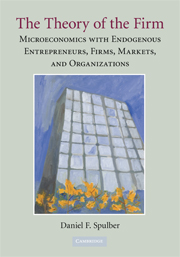 The Theory of the Firm
The Theory of the Firm Book contents
- Frontmatter
- Contents
- Preface and Acknowledgments
- Introduction
- PART I THE THEORY OF THE FIRM
- 1 The Consumer
- 2 The Firm
- 3 The Separation of Consumer Objectives and Firm Objectives
- PART II THE ENTREPRENEUR IN EQUILIBRIUM
- PART III HUMAN CAPITAL, FINANCIAL CAPITAL, AND THE ORGANIZATION OF THE FIRM
- PART IV INTERMEDIATION BY THE FIRM
- PART V MARKET MAKING BY THE FIRM
- 12 Conclusion
- References
- Author Index
- Subject Index
3 - The Separation of Consumer Objectives and Firm Objectives
Published online by Cambridge University Press: 05 June 2012
- Frontmatter
- Contents
- Preface and Acknowledgments
- Introduction
- PART I THE THEORY OF THE FIRM
- 1 The Consumer
- 2 The Firm
- 3 The Separation of Consumer Objectives and Firm Objectives
- PART II THE ENTREPRENEUR IN EQUILIBRIUM
- PART III HUMAN CAPITAL, FINANCIAL CAPITAL, AND THE ORGANIZATION OF THE FIRM
- PART IV INTERMEDIATION BY THE FIRM
- PART V MARKET MAKING BY THE FIRM
- 12 Conclusion
- References
- Author Index
- Subject Index
Summary
The separation criterion is fundamental to the theory of the firm. A firm is defined as a transaction institution whose objectives differ from those of its consumer-owners. To understand the firm's economic contribution, it is necessary to derive the firm's objectives endogenously from the choices made by the firm's owners. The neoclassical separation theorem shows that the firm's objective is profit maximization. Although the neoclassical separation theorem provides essential guidance, it is based on several critical assumptions: transaction costs are absent, the firm is defined as a producer of goods, firms take prices as given, and the Walrasian auctioneer chooses market-clearing prices. This chapter extends the separation theorem to accommodate a more general model of the firm. The theory of the firm emphasizes that the firm is more than a producer of goods. The firm chooses prices and creates markets. The discussion in this chapter shows that when firms choose prices, the firm's owners continue to want the firm to maximize profits.
The firm's profit-maximization objective is distinct from the consumption objectives of its owners. Profit maximization by firms is a critical feature of neoclassical analysis of general equilibrium, industrial organization models of imperfect competition, and models of market microstructure. In the theory of the firm, profit maximization drives the firm to select allocations that are more efficient than direct exchange, under some conditions. Profit maximization gives the firm enhanced capabilities in comparison to consumer organizations such as cooperatives, nonprofits, and basic partnerships.
- Type
- Chapter
- Information
- The Theory of the FirmMicroeconomics with Endogenous Entrepreneurs, Firms, Markets, and Organizations, pp. 125 - 148Publisher: Cambridge University PressPrint publication year: 2009


